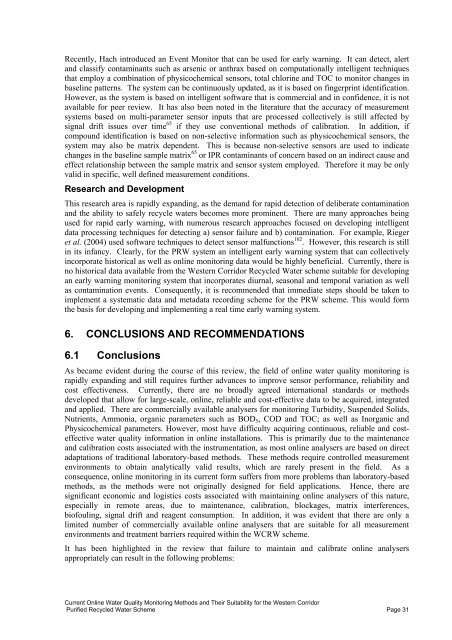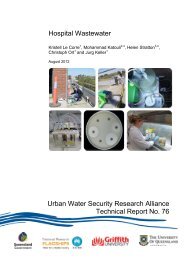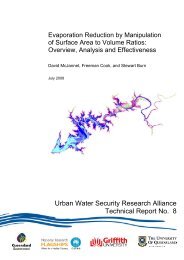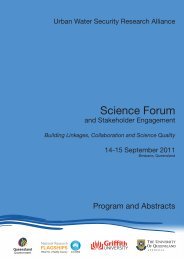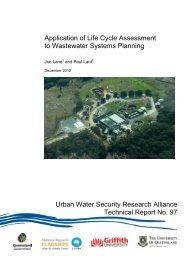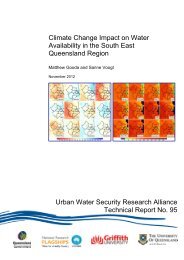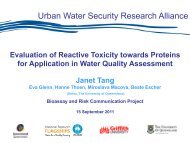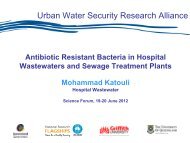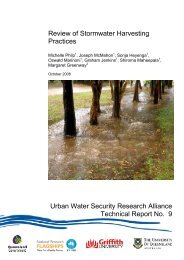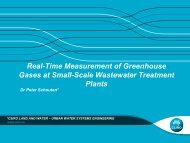Current online water quality monitoring methods and their suitability ...
Current online water quality monitoring methods and their suitability ...
Current online water quality monitoring methods and their suitability ...
You also want an ePaper? Increase the reach of your titles
YUMPU automatically turns print PDFs into web optimized ePapers that Google loves.
Recently, Hach introduced an Event Monitor that can be used for early warning. It can detect, alert<strong>and</strong> classify contaminants such as arsenic or anthrax based on computationally intelligent techniquesthat employ a combination of physicochemical sensors, total chlorine <strong>and</strong> TOC to monitor changes inbaseline patterns. The system can be continuously updated, as it is based on fingerprint identification.However, as the system is based on intelligent software that is commercial <strong>and</strong> in confidence, it is notavailable for peer review. It has also been noted in the literature that the accuracy of measurementsystems based on multi-parameter sensor inputs that are processed collectively is still affected bysignal drift issues over time 65 if they use conventional <strong>methods</strong> of calibration. In addition, ifcompound identification is based on non-selective information such as physicochemical sensors, thesystem may also be matrix dependent. This is because non-selective sensors are used to indicatechanges in the baseline sample matrix 65 or IPR contaminants of concern based on an indirect cause <strong>and</strong>effect relationship between the sample matrix <strong>and</strong> sensor system employed. Therefore it may be onlyvalid in specific, well defined measurement conditions.Research <strong>and</strong> DevelopmentThis research area is rapidly exp<strong>and</strong>ing, as the dem<strong>and</strong> for rapid detection of deliberate contamination<strong>and</strong> the ability to safely recycle <strong>water</strong>s becomes more prominent. There are many approaches beingused for rapid early warning, with numerous research approaches focused on developing intelligentdata processing techniques for detecting a) sensor failure <strong>and</strong> b) contamination. For example, Riegeret al. (2004) used software techniques to detect sensor malfunctions 102 . However, this research is stillin its infancy. Clearly, for the PRW system an intelligent early warning system that can collectivelyincorporate historical as well as <strong>online</strong> <strong>monitoring</strong> data would be highly beneficial. <strong>Current</strong>ly, there isno historical data available from the Western Corridor Recycled Water scheme suitable for developingan early warning <strong>monitoring</strong> system that incorporates diurnal, seasonal <strong>and</strong> temporal variation as wellas contamination events. Consequently, it is recommended that immediate steps should be taken toimplement a systematic data <strong>and</strong> metadata recording scheme for the PRW scheme. This would formthe basis for developing <strong>and</strong> implementing a real time early warning system.6. CONCLUSIONS AND RECOMMENDATIONS6.1 ConclusionsAs became evident during the course of this review, the field of <strong>online</strong> <strong>water</strong> <strong>quality</strong> <strong>monitoring</strong> israpidly exp<strong>and</strong>ing <strong>and</strong> still requires further advances to improve sensor performance, reliability <strong>and</strong>cost effectiveness. <strong>Current</strong>ly, there are no broadly agreed international st<strong>and</strong>ards or <strong>methods</strong>developed that allow for large-scale, <strong>online</strong>, reliable <strong>and</strong> cost-effective data to be acquired, integrated<strong>and</strong> applied. There are commercially available analysers for <strong>monitoring</strong> Turbidity, Suspended Solids,Nutrients, Ammonia, organic parameters such as BOD 5 , COD <strong>and</strong> TOC; as well as Inorganic <strong>and</strong>Physicochemical parameters. However, most have difficulty acquiring continuous, reliable <strong>and</strong> costeffective<strong>water</strong> <strong>quality</strong> information in <strong>online</strong> installations. This is primarily due to the maintenance<strong>and</strong> calibration costs associated with the instrumentation, as most <strong>online</strong> analysers are based on directadaptations of traditional laboratory-based <strong>methods</strong>. These <strong>methods</strong> require controlled measurementenvironments to obtain analytically valid results, which are rarely present in the field. As aconsequence, <strong>online</strong> <strong>monitoring</strong> in its current form suffers from more problems than laboratory-based<strong>methods</strong>, as the <strong>methods</strong> were not originally designed for field applications. Hence, there aresignificant economic <strong>and</strong> logistics costs associated with maintaining <strong>online</strong> analysers of this nature,especially in remote areas, due to maintenance, calibration, blockages, matrix interferences,biofouling, signal drift <strong>and</strong> reagent consumption. In addition, it was evident that there are only alimited number of commercially available <strong>online</strong> analysers that are suitable for all measurementenvironments <strong>and</strong> treatment barriers required within the WCRW scheme.It has been highlighted in the review that failure to maintain <strong>and</strong> calibrate <strong>online</strong> analysersappropriately can result in the following problems:<strong>Current</strong> Online Water Quality Monitoring Methods <strong>and</strong> Their Suitability for the Western CorridorPurified Recycled Water Scheme Page 31


